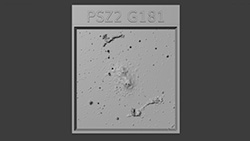CXC Home | Search | Help | Image Use Policy | Latest Images | Privacy | Accessibility | Glossary | Q&A
1
X-ray, Optical, and Radio Images of PSZ2 G181.06+48.47Credit: X-ray: NASA/CXC/CfA/Stroe, A. et al.; Optical: PanSTARRS; Radio: ASTRON/LOFAR; Image Processing: NASA/CXC/SAO/N. Wolk
Observations from Chandra and other telescopes have captured a powerful cosmic event: two galaxy clusters have collided and are now poised to head back for another swipe at each other. Galaxy clusters are some of the largest structures in the Universe held together by gravity. In these images, X-rays from Chandra and ESA’s XMM-Newton have been combined with LOFAR data and an optical image from Pan-STARRs of the stars and galaxies in the field of view.
2
3D Printable Files: of PSZ2 G181(3D Print Credit: NASA/CXC/A. Jubett, using software by Tactile Universe/N. Bonne & C. Krawczyk & Blender)
This tactile plate is a physical relief map based on the intensity of Chandra X-ray & XMM-Newton data along with optical and radio data, featuring a dramatic cosmic story unfolding 2.8 billion light years from Earth: the fallout when two galaxy clusters collide. At the center of the plate are the colliding galaxy clusters, which together are known as PSZ2 G181. This combined cluster somewhat resembles an irregular peanut shell, with bulbous ends linked by a tapered middle. Inside each bulbous end are several raised dots; some of the galaxies within the clusters. The peanut shape is tilted at a slight angle, surrounded by a cloud of X-ray gas. Far from the bulbous ends, at our upper left and lower right, are two blotchy, thick lines. These are probably shock fronts, similar to those created by jets that have broken the sound barrier. Bracketing the combined galaxy cluster, these shock fronts were caused by the initial collision about a billion years ago. They are currently separated by 11 million light-years. New data from the Chandra and XMM-Newton observatories suggests that PSZ2 G181 is poised for another powerful cosmic event. Having already taken one swipe at each other, the two clusters within are once again on a collision course.
Return to: Galaxy Clusters on Course to Crash Again, NASA's Chandra Finds (June 4, 2025)








